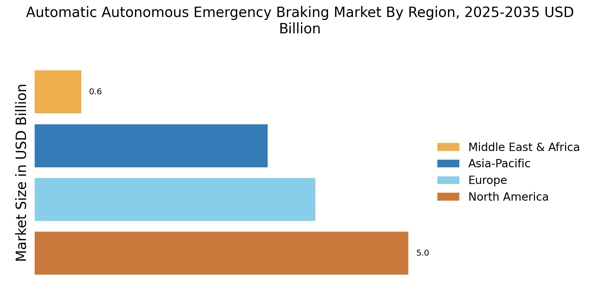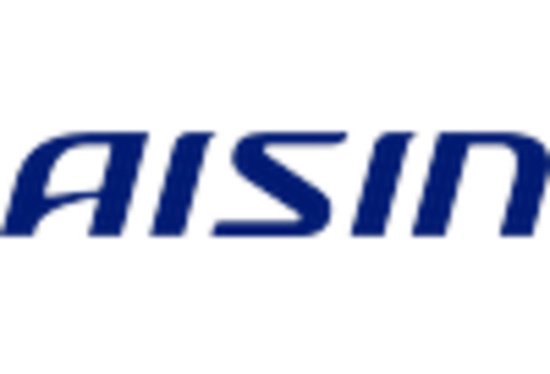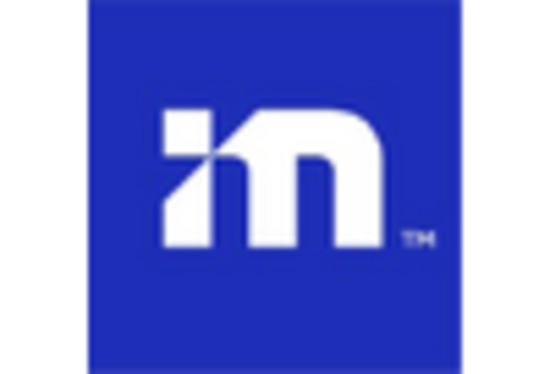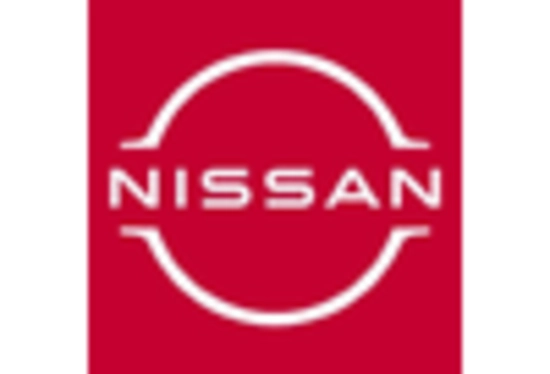The Automatic Autonomous Emergency Braking Market is currently characterized by a dynamic competitive landscape, driven by technological advancements and increasing regulatory mandates for vehicle safety. Key players such as Bosch (Germany), Continental (Germany), and Mobileye (Israel) are at the forefront, each adopting distinct strategies to enhance their market positioning. Bosch (Germany) emphasizes innovation through substantial investments in research and development, focusing on integrating advanced sensor technologies into their braking systems. Meanwhile, Continental (Germany) has pursued strategic partnerships with automotive manufacturers to embed their systems in a wider range of vehicles, thereby expanding their market reach. Mobileye (Israel), known for its cutting-edge computer vision technology, is leveraging its expertise to develop more sophisticated autonomous systems, which positions it as a leader in the integration of AI with braking technologies.
In terms of business tactics, companies are increasingly localizing manufacturing to reduce costs and enhance supply chain efficiency. This trend is particularly evident in the context of the global supply chain disruptions experienced in recent years. The market structure appears moderately fragmented, with several players vying for dominance, yet the collective influence of major companies like Bosch, Continental, and Mobileye is shaping the competitive dynamics significantly. Their strategies not only enhance their individual market shares but also contribute to a more robust overall market environment.
In August 2025, Bosch (Germany) announced the launch of a new generation of its Automatic Emergency Braking system, which incorporates enhanced AI algorithms for improved decision-making in emergency situations. This strategic move is likely to bolster Bosch's competitive edge by offering superior safety features that align with evolving consumer expectations and regulatory requirements. Furthermore, this innovation may set a new benchmark for performance standards in the industry, compelling competitors to accelerate their own development efforts.
In September 2025, Continental (Germany) entered into a partnership with a leading electric vehicle manufacturer to integrate its advanced braking systems into upcoming models. This collaboration not only signifies Continental's commitment to expanding its footprint in the electric vehicle segment but also highlights the growing trend of automakers seeking to enhance safety features in their electric offerings. Such partnerships are indicative of a broader shift towards collaborative innovation in the industry, where companies leverage each other's strengths to deliver enhanced value to consumers.
In October 2025, Mobileye (Israel) revealed its plans to expand its operations in Asia, focusing on partnerships with local automotive manufacturers to tailor its technology to regional market needs. This strategic expansion is expected to enhance Mobileye's presence in a rapidly growing market, allowing it to capitalize on the increasing demand for advanced safety features in vehicles. By localizing its approach, Mobileye may effectively address specific consumer preferences and regulatory standards, thereby solidifying its competitive position.
As of October 2025, the Automatic Autonomous Emergency Braking Market is witnessing a pronounced shift towards digitalization, sustainability, and AI integration. These trends are reshaping the competitive landscape, with companies increasingly forming strategic alliances to enhance their technological capabilities and market reach. The focus appears to be shifting from traditional price-based competition to a more nuanced approach centered on innovation, technological advancement, and supply chain reliability. This evolution suggests that future competitive differentiation will hinge on the ability to deliver cutting-edge solutions that not only meet regulatory standards but also resonate with consumer expectations for safety and performance.


















Leave a Comment